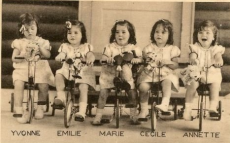
The Dionne quintuplets were the first quintuplets--a set of five identical babies born at once--known to have survived their infancy. Unfortunately, their parents and the Canadian government turned the sisters into a tourist attraction, using them to make money without thinking about what was best for the children.
Yvonne, Annette, Cécile, Émilie and Marie were born two months early on May 28th 1934. Their birth and survival were quite miraculous; before the Dionnes no one was aware that quintuplets were even possible! The doctor, Allan Roy Dafoe, needed the help of two midwives to deliver the babies.
Oliva-Edouard and Elzire Dionne already had five older children, and were not very rich. They lived in a farmhouse near the village of Corbeil, just outside Ontario in the east of Canada. News of the amazing birth spread quickly, and the Dionne family were keen to make the most out of their good luck. Oliva’s brother asked a local newspaper how much they would pay for the birth announcement, and soon people all over North America knew about the sisters.
Many people wrote to the Dionnes with advice or sent them useful supplies. Others were more interested in how the quintuplets could bring them money and fame. Within days of the girls’ birth, a representative from the World’s Fair in Chicago approached their parents and asked to display them as part of the Century of Progress exhibition. Oliva and Elzire agreed and although the babies didn’t end up as part of the exhibition, this was an ominous sign of things to come.
When the girls were four months old the Ontario government declared the Dionnes as unfit parents, though not for their other five children. The quints were removed from their parents care, and Dr Dafoe was put in charge of their welfare. At first this was meant to be temporary, but the government soon saw how interested the public were in the sisters and spotted an opportunity. The quintuplets were made wards of the crown until they were 18, which meant they couldn’t go back to live with their family.
The girls were moved to the Dafoe Hospital and Nursery, which was built across the road from the old farmhouse for the sisters and their nurses to live in. They had a regimented life at the Nursery, following the same routine every day and eating meals, praying and learning at set times. Most disturbingly the girls spent an hour each day in the compound’s playground, which had been designed as a public observation area. Around 6000 tourists came to view the quintuplets everyday. Their father opened a souvenir stand opposite the Nursery and even sold rocks from the family’s farm, claiming that they had special powers. Soon the site was nicknamed ‘Quintland’, and became one of Ontario’s most popular attractions.
Eventually in 1943 the Dionnes won back custody of the quintuplets. Unfortunately they never treated the girls well, despite the fact that they now lived in a huge mansion which the fund from ‘Quintland’ had paid for. As soon as they were 18 the sisters moved away from home and had little contact with their parents. They also stayed out of the public eye for the rest of their lives, speaking publicly only when the McCaughley septuplets were born. They wrote to the parents of the seven babies, warning them not to use the children for fame, saying:
“We sincerely hope a lesson will be learned from examining how our lives were forever altered by our childhood experience. If this letter changes the course of events for these newborns, then perhaps our lives will have served a higher purpose.”
Image: https://upload.wikimedia.org/wikipedia/commons/e/e3/Dionne_quintuplets1937.jpg

0 Comment:
Be the first one to comment on this article.